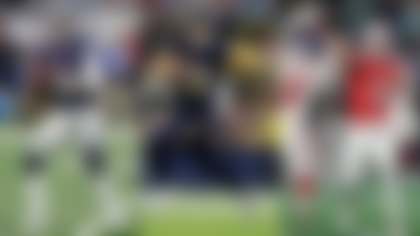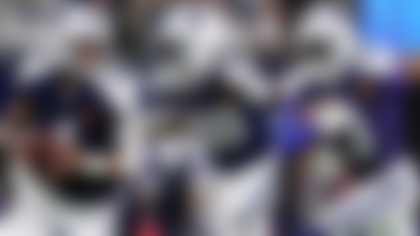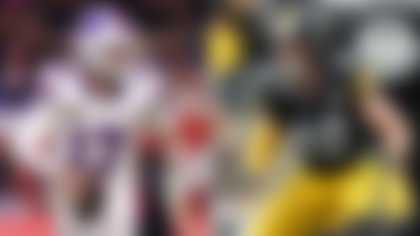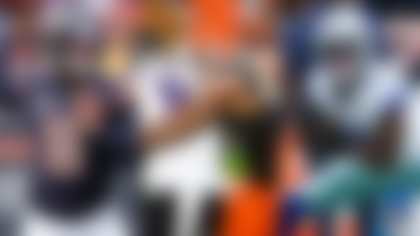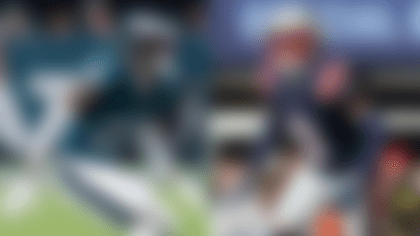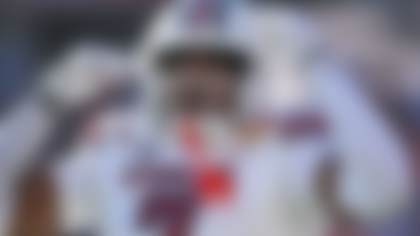Which teams got it right on fourth-down and 2-point conversion calls in Week 6 of the 2021 NFL season -- and which teams got it wrong? The Next Gen Stats analytics team uses the Next Gen Stats Decision Guide powered by AWS to break down the numbers behind the decisions that shaped the game.

Chargers twice fail to convert on fourth down in own territory
Facing a double-digit deficit on the road in Baltimore, Chargers head coach Brandon Staley knew the best chance to keep his team in the game was to be aggressive on fourth down. The Chargers went for it from their own territory twice; however, the offense failed to convert on both tries. The NGS Decision Guide had both calls as only "slight" go-for-it situations for the Chargers, which quantifiably means the difference between going for it and punting was worth less than 2 percentage points in expected win probability.
It wasn’t the decisions to go for it that were suboptimal, it was the design of the play calls. We can use the full Next Gen Stats toolbox of models to break it all down ...
SECOND QUARTER: With 9:13 remaining and the Chargers (trailing 14-0) facing a fourth-and-3 from their own 39-yard line, Justin Herbert fails to connect with Mike Williams on a hitch route, and the pass falls incomplete.
The NGS Decision Guide had this call as a go for it by a difference of 1.2 percentage points in expected win probability. If the Chargers converted, the team’s chances of winning would have increased from 9.7 percent to 12.1 percent. If they punted, their win probability would have decreased to 8.2 percent. And if they failed to convert (as they did), their win probability would have fallen to 6.6 percent. If we combine each probability with the chances of converting (51.5 percent), then Staley was right -- analytically speaking -- to keep his offense on the field.
Where the Chargers went wrong, however, was with their suboptimal play call.
Before the play, the NGS Decision Guide had the Chargers’ chances of converting through the air at 51.9 percent. However, the hitch route Williams ran had just a 44.3 percent chance to be completed, according to our completion probability model. Williams had just 0.2 yards of separation from Ravens cornerback Marlon Humphrey when Herbert's pass arrived. Not surprisingly, the pass fell incomplete and the Chargers turned it over on downs.
THIRD QUARTER: With 5:58 remaining and the Chargers (trailing 24-6) facing a fourth-and-1 from their own 19-yard line, Herbert fails to connect with Josh Palmer on a nearly identical play call to their earlier fourth-down try.
While the scoreboard read fourth-and-1 in the stadium, this was not a true yard-to-go situation, per our ball-tracking technology. We had the distance to the first-down marker at 1.9 yards. Nevertheless, our model recommended the Chargers go for it. It's worth noting, though, the recommendation added just 0.4 percentage points in expected win probability. With a potential gain so small, this recommendation is more of a toss-up between going for it and punting. The win probability in this instance is based on the Chargers having a 56 percent chance to convert, per our conversion probability model; however, just like with the team's fourth-down call in the second quarter, offensive coordinator Joe Lombardi drew up the same low-probability route combination -- another back-shoulder hitch route to an isolated receiver -- this time intended for Palmer. The completion probability of Herbert’s pass intended for the rookie? 46.1 percent. The probability of converting if they had run the football? 57.7 percent.
Entering Week 6, the Chargers' offense had gone 7 for 7 on fourth-down tries. The team's only failed fourth-down attempt this season came on a fake punt-pass in Week 4 against the Raiders.

Mike McCarthy’s tale of two halves
McCarthy and the NGS Decision Guide were in full agreement on all four of the Cowboys' fourth-down situations against the Patriots in the first half, three of which were strong go-for-it recommendations, according to our model. The second half, however, was a different story.
FIRST QUARTER: With 12:04 remaining, the Cowboys (tied 0-0) faced a fourth-and-1 from their own 34-yard line. Ezekiel Elliott was stuffed for no gain, and the Patriots took over.
We care more about the process than outcome when it comes to evaluating fourth-down decisions. In this case, McCarthy was right to go for it, despite the offense not converting on the play. The NGS Decision Guide recommended Dallas go for it instead of punt by a difference of 2.6 percentage points in win probability value. This was driven heavily by the Cowboys' chances of converting if they went for it (73.9 percent), which increases even more if they called a run play (77.2 percent).
FIRST QUARTER: With 2:30 remaining, the Cowboys (trailing 14-7) faced a fourth-and-1 from their own 47-yard line and successfully converted on an Elliott run that bounced outside the tackles.
Another fourth-and-short, another Elliott run call. With offensive lineman Connor McGovern lined up as a fullback, Elliott took the handoff and cut sharply to the left edge to pick up 3 yards and earn a new set of downs. We had that play as a 5.7 percent decision in favor of going for it.
SECOND QUARTER: With 1:32 remaining and the Cowboys (trailing 14-10) facing a fourth-and-goal from the Patriots' 1-yard line, Dak Prescott fumbles prior to crossing the goal line on a QB sneak attempt.
After failing to score on three previous tries from the 1-yard line, McCarthy once again opted to go for it. Our model strongly supported this decision, with a 10.4 percentage-point difference in win probability value. Although the decision meshed with the analytics, the failed attempt did result in a loss of 24 percentage points in expected win probability value.
FOURTH QUARTER: With 2:47 remaining and the Cowboys (trailing 21-20) facing a fourth-and-2 from the Patriots' 33-yard line, Dallas’ Greg Zuerlein misses a 51-yard field-goal attempt.
McCarthy's fourth-down aggressiveness hit an abrupt wall as the game reached its final moments. Per the NGS Decision Guide, going for it here would've yielded 4.6 percentage points in win probability value. Part of the model’s recommendation accounted for the conversion probabilities of going for it (59%) versus kicking a field goal (55%). Furthermore, Dallas’ win probability would have increased to 70 percent with a successful conversion. A conversion also would have allowed Dallas to burn more clock to set up a potential game-winning field goal with significantly less time remaining.
FOURTH QUARTER: With 24 seconds remaining and the Cowboys (trailing 29-26) facing a fourth-and-1 from the Patriots' 31-yard line, Zuerlein makes a 49-yard field goal.
Let's ignore the fact that McCarthy oddly called one of his two remaining timeouts to kick a field goal with 24 seconds left instead of letting the clock wind down to sub-5 seconds first. Given the situation, and the timeout, the optimal call was to go for it by 16 percentage points of win probability value.
The NGS Decision Guide estimates the Cowboys had a 74 percent probability of converting the fourth-and-1, compared to a 62 percent probability of making the 49-yard field-goal try. Ultimately, Zuerlein effectively sent the game into overtime, though it was still a risky decision, given that the guide pegged a make as giving the Cowboys -- with one timeout left -- a 58 percent chance (roughly the chances of winning in overtime) to win. If the Cowboys had converted on the fourth-and-1, however, they would have been able to either take their chances at the end zone or try a closer, more high-percentage field goal.


Eagles stick with aggressive 2-point approach
Trying to come back from a 14-point deficit late in the fourth quarter, most teams will kick the extra point upon scoring a touchdown, in an attempt to play for overtime. Facing that situation on Thursday night, however, Eagles head coach Nick Sirianni showed his continued faith in a strategy pioneered by his predecessor, Doug Pederson:
FOURTH QUARTER: With 5:54 remaining and the Eagles trailing 28-20, Jalen Hurts successfully converts a 2-point try with a pass to Quez Watkins.
At this point in the game, the Eagles faced long odds to pull off a comeback. After scoring the touchdown, our win probability model had their chances of winning at 8 percent. Regardless of whether they decided to kick the extra point or try for 2, the Eagles still would have had to make a stop and score another touchdown to even have a chance. Let us not forget: The Eagles were heavy underdogs. If the game had gone to overtime, their chances of winning would have been less than 50 percent.
While the NGS Decision Guide found the difference in expected win probability between kicking the extra point and going for 2 to be virtually nil, the context of the game supported going for 2, which came with a probability of success of 56 percent. Having converted for 2, Philly would have been able to take the lead with a made extra point after scoring another touchdown, presuming the defense could get a stop -- this was the team's best path to winning in regulation. Even if the offense had failed the 2-point try, the Eagles would still have another opportunity to tie via another 2-point attempt following a second touchdown.
Notably, the Eagles have now accounted for two of the three go-for-2-when-down-8 decisions made this season, and five of the 14 dating back to 2017.
Follow the Next Gen Stats team on Twitter.



